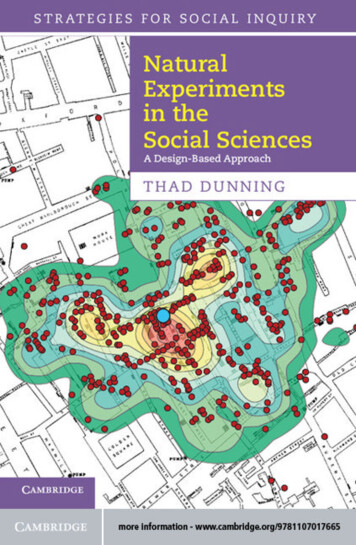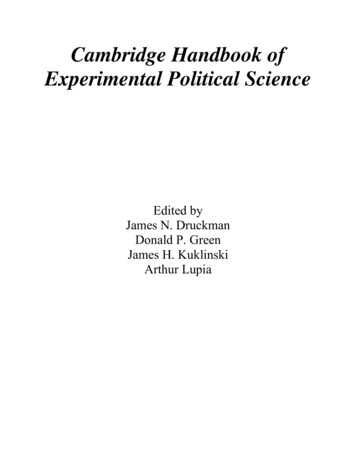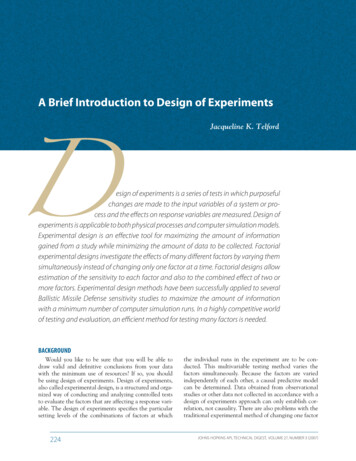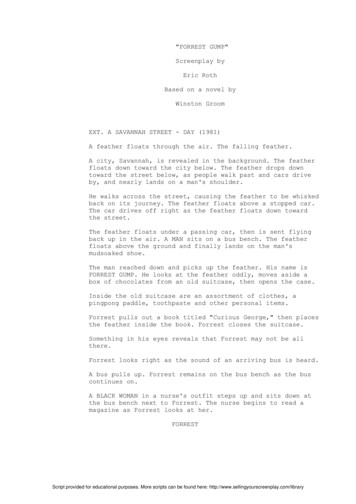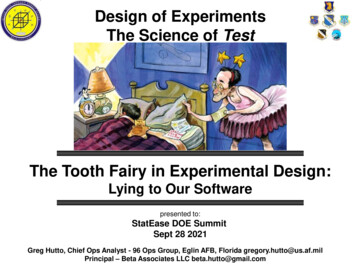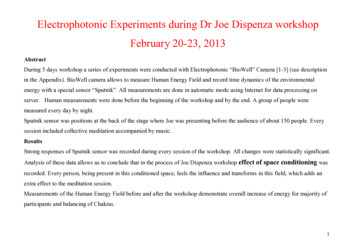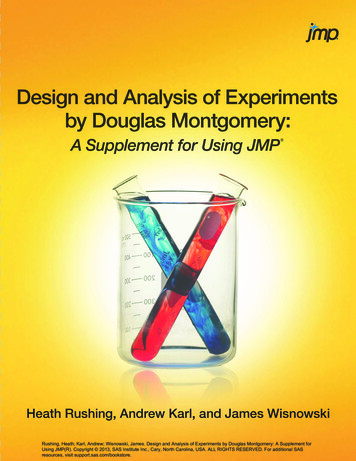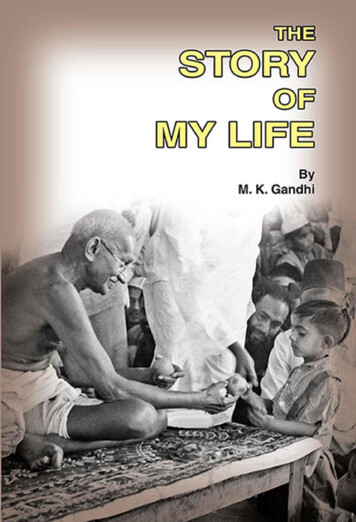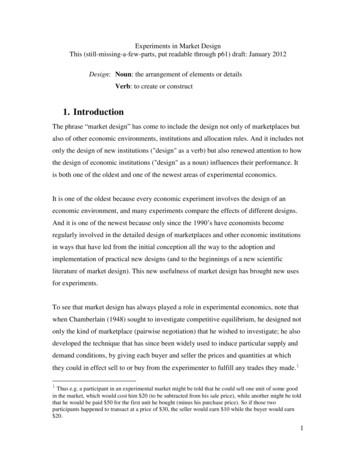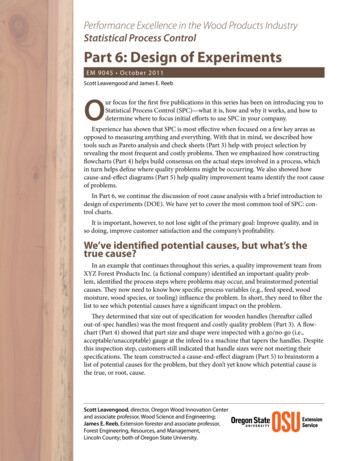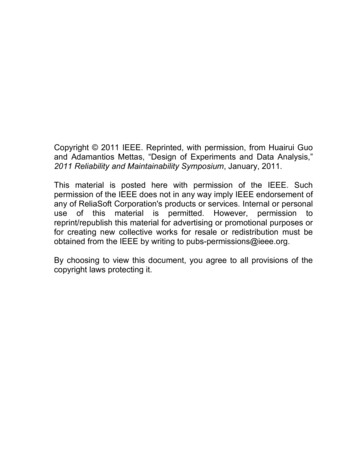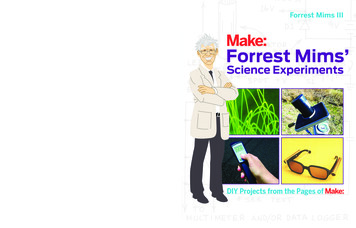
Transcription
Science/Experiments & ProjectsForrest Mims IIIScientific discoveries aren’t made only by professionals. Amateur and citizen scientists havemade many discoveries that working scientists use. In fact, many institutions—includingNASA—rely on the work and discoveries of amateurs. Amateur scientists have discoveredsignificant dinosaur fossils, found new species of plants, and identified new comets andasteroids. Their discoveries have been published in scientific journals and books.With this book, you’ll learn how to: Study tree rings Extract scientific data from digital images—and make music from the data Investigate the different things that snow can do Use a digital scanner to assist with essential Modify and mount temperature sensorsscientific inquiries Sense and record movement as with an optical Mine data to most efficiently glean online infofiber seismometer properly record your scientific inquiries— Construct automatic sunshine recordersand discoveries! Use and calibrate your own essential tool, the Organize your own space-themed Mars-botinfrared thermometer competition Capture and study airborne particles with your Photograph the solar aureole, which you can’town air samplersee with your bare eyes Track the most important greenhouse gasUse LEDs to detect light and track nighttime Build a twilight photometer that can measure to projectilesthe top of the stratosphereYou’ll even learn fun facts about Thomas Jefferson, the first Maker president; how the PCrevolution took off; and what to do when things fail—because they will! Failure is part oflearning and part of making, but there’s no time to worry about that—you have so much tolearn, explore, analyze, discover, and make!Forrest Mims’ Science ExperimentsWritten by the foremost amateur scientist in the U.S. today, Forrest Mims’ ScienceExperiments covers many ways you can enter the world of amateur science. You’ll learn theessential skills, methods, and procedures that you need to begin working, thinking, inquiring,and recording like a real scientist.Author Forrest M. Mims III, an amateur scientist and Rolex Award winner, is the most widely readelectronics author in the world, and was named one of the “50 Best Brains in Science” by Discovermagazine. His 60 books have sold over 7.5 million copies and have twice been honored for excellenceby the Computer Press Association.MimsUS 19.99 CAN 22.99ISBN: 978-1-680-45117-7makezine.comForrest Mims’Science ExperimentsDIY Projects from the Pages of
Forrest Mims’Science ExperimentsDIY Projects from the Pages of Make:Forrest Mims
Forrest Mims’ Science ExperimentsDIY Projects from the Pages of Make:By Forrest MimsCopyright 2016 Forrest Mims. All rights reserved.Printed in Canada.Published by Maker Media, Inc.,1160 Battery Street East, Suite 125San Francisco, California 94111Maker Media books may be purchased for educational, business, or sales promotional use. Onlineeditions are also available for most titles (safaribooksonline.com). For more information, contactour corporate/institutional sales department: 800-998-9938 or corporate@oreilly.com.Publisher: Roger StewartEditor: Patrick DiJustoCopy Editor: Nancy Peterson, Happenstance Type-O-RamaProofreader: Scout Festa, Happenstance Type-O-RamaInterior Designer and Compositor: Maureen Forys, Happenstance Type-O-RamaIllustration: Richard Sheppard, Happenstance Type-O-RamaCover Designer: Maureen Forys, Happenstance Type-O-RamaIndexer: Valerie Perry, Happenstance Type-O-RamaSeptember 2016: First EditionRevision History for the First Edition2016-07-25: First ReleaseSee oreilly.com/catalog/errata.csp?isbn 9781680451177 for release details.Make:, Maker Shed, and Maker Faire are registered trademarks of Maker Media, Inc. The MakerMedia logo is a trademark of Maker Media, Inc. Forrest Mims’ Science Experiments and relatedtrade dress are trademarks of Maker Media, Inc.Many of the designations used by manufacturers and sellers to distinguish their products areclaimed as trademarks. Where those designations appear in this book, and Maker Media, Inc. wasaware of a trademark claim, the designations have been printed in caps or initial caps.While the publisher and the author have used good faith efforts to ensure that the informationand instructions contained in this work are accurate, the publisher and the author disclaim allresponsibility for errors or omissions, including, without limitation, responsibility for damagesresulting from the use of or reliance on this work. Use of the information and instructions contained in this work is at your own risk. If any code samples or other technology this work contains or describes is subject to open source licenses or the intellectual property rights of others, itis your responsibility to ensure that your use thereof complies with such licenses and/or rights.978-1-680-45117-7
Safari Books OnlineSafari Books Online is an on-demand digital library that delivers expert content in both book andvideo form from the world’s leading authors in technology and business.Technology professionals, software developers, web designers, and business and creative professionals use Safari Books Online as their primary resource for research, problem-solving, learning, and certification training.Safari Books Online offers a range of plans and pricing for enterprise, government, education,and individuals. Members have access to thousands of books, training videos, and prepublicationmanuscripts in one fully searchable database from publishers like O’Reilly Media, Prentice HallProfessional, Addison- Wesley Professional, Microsoft Press, Sams, Que, Peachpit Press, FocalPress, Cisco Press, John Wiley & Sons, Syngress, Morgan Kaufmann, IBM Redbooks, Packt,Adobe Press, FT Press, Apress, Manning, New Riders, McGraw-Hill, Jones & Bartlett, Course Technology, and hundreds more. For more information about Safari Books Online, please visitus online.How to Contact UsPlease address comments and questions concerning this book to the publisher:Make:1160 Battery Street East, Suite 125San Francisco, CA 94111877-306-6253 (in the United States or Canada)707-639-1355 (international or local)Make: unites, inspires, informs, and entertains a growing community of resourceful people whoundertake amazing projects in their backyards, basements, and garages. Make: celebrates yourright to tweak, hack, and bend any technology to your will. The Make: audience continues to be agrowing culture and community that believes in bettering ourselves, our environment, our educational system—our entire world. This is much more than an audience; it’s a worldwide movement that Make: is leading and we call it the Maker Movement.For more information about Make:, visit us online: Make: magazine makezine.com/magazineMaker Faire makerfaire.comMakezine.com makezine.comMaker Shed makershed.comTo comment or ask technical questions about this book, send email to bookquestions@oreilly.com.
DedicationThis book is dedicated to my late father, Forrest M. Mims Jr., and my wife Minnie, both of whom encouraged my pursuit of science, and our three children, Eric, Vicki and Sarah, each of whom produced outstanding science fairprojects during their school years.AcknowledgmentsThis book owes much to former MAKE: Magazine editor Mark Frauenfelder,who understands better than anyone the motivations that drive and inspireboth makers and amateur scientists. It was Mark who assigned the column inMAKE: that evolved into this book.
ContentsPreface . . . . . . . . . . . . . . . . . . . . vii1 How to Study Tree Rings . . . . . . . . . . . . . 12 Snow Science . . . . . . . . . . . . . . . . . . 73 Tracking Heat Islands . . . . . . . . . . . . . . 154 Vibration Sensors . . . . . . . . . . . . . . .215 Make an Experimental Optical FiberSeismometer . . . . . . . . . . . . . . . . .276 Ultra-Simple Sunshine Recorders . . . . . . . .337 The Infrared Thermometer: An EssentialScience Gadget . . . . . . . . . . . . . . . . 398 Capturing and Studying Airborne Dust, Smoke,and Spores . . . . . . . . . . . . . . . . . .479 Track the Leading Greenhouse Gas . . . . . . . . 5510 Build a Twilight Photometer, part 1 . . . . . . . . 6311 Build a Twilight Photometer, part 2 . . . . . . . . 7112 How to Analyze Scientific Images . . . . . . . .7713 Doing Science with a Digital Scanner . . . . . . . 8314 Data Mining: How to Analyze OnlineScientific Data . . . . . . . . . . . . . . . . . 91
15 Using Sensors with Dataloggers . . . . . . . . . 9916 How to Document What You Make or Discover . .10717 MARS-BOT: Adding Science to Robotics . . . . . 11318 How to Photograph the Solar Aureole . . . . . .11919 Record Your World from a Picture Post . . . . . . 12520 Digital Pinhole Photography . . . . . . . . . .13321 How to Make and Use Retroreflectors . . . . . .14122 How to Use LEDs to Detect Light . . . . . . . . . 14723 Use LEDs to Track Night-Launched Projectiles . .15324 Connecting Fibers to LEDs and Sensors . . . . .15925 Transform Things into Sounds with the PunkPAC .16526 Making Synthesized Music from Your Data . . . .17327 Startups: Origins of the PC Revolution . . . . . . 18128 Thomas Jefferson: Maker in Chief . . . . . . . . 18329 The Kit That Launched the Tech Revolution . . . . 19330 When Projects Fail . . . . . . . . . . . . . .199Index . . . . . . . . . . . . . . . . . . . . 205
Preface:Becoming an Amateur ScientistAn editorial in a leading science journal onceproclaimed an end to amateur science: “Modern science can no longer be done by giftedamateurs with a magnifying glass, copperwires, and jars filled with alcohol.” I grinnedas I read these words. For then as now there’sa 10 magnifier in my pocket, spools of copper wire on my workbench, and a nearby jarof methanol for cleaning the ultraviolet filtersin my homemade solar ultraviolet and ozonespectroradiometers. Yes, modern science usesconsiderably more sophisticated methods andinstruments than in the past. And so do weamateurs. When we cannot afford the newest scientific instrument, we wait to buy iton the surplus market or we build our own.Sometimes the capabilities of our homemadeinstruments rival or even exceed those of theirprofessional counterparts.
So began an essay about amateur science I was asked to write for Science(April 1999, full),one of the world’s leading science journals. Ironically, the quotation inthe first sentence came from an editorial that Science had previouslypublished.In the years since my essay appeared in Science, amateur scientists havecontinued doing what they’ve done for centuries. They’ve discoveredsignificant dinosaur fossils, found new species of plants, and identifiedmany new comets and asteroids. Their discoveries have been publishedin scientific journals and books. Likewise, thousands of websites detailan enormous variety of amateur science tips, projects, activities, and discoveries. Ralph Coppola has listed many of these sites in “Wanderings,”his monthly column in The Citizen Scientist ay’s amateur scientists have access to sophisticated components,instruments, computers, and software that could not even be imaginedback in 1962 when I built my first computer, a primitive analog device thatcould translate 20 words of Russian into English with the help of a memory composed of 20 trimmer resistors s like multiwavelength LEDs and laser diodes can be used tomake spectroradiometers and instruments that measure the transmission of light through the atmosphere. Images produced by digital videoand still cameras can be analyzed with free software like ImageJ to studythe natural world in ways that weren’t even imagined a few decades ago.Amateur astronomers can mount affordable digital cameras on their telescopes, which then scan the heavens under computer control.Cameras, microscopes, telescopes, and many other preassembled products can be modified or otherwise hacked to provide specialized scientificinstruments. For example, digital camera sensors are highly sensitive tothe near-infrared wavelengths beyond the limits of human vision fromaround 800nm–900nm. IR-blocking filters placed over camera sensorsblock the near-IR so that photographs depict images as they’d be seen byviiiForrest Mims’ Science Experiments
the human eye. Removing the near-IR filter provides a camera that canrecord the invisible wavelengths reflected so well by healthy foliage.Many of the makers who publish their projects in the pages of MAKE,Nuts and Volts, and across the web have the technical skills and resourcesto devise scientific tools and instruments far more advanced than anything my generation of amateur scientists designed. They also have theability to use these tools to begin their own scientific measurements,studies, and surveys. Thus, they have the potential to become the pioneers for the next generation of serious amateur scientists.This book covers some of the many ways you can enter the world ofamateur science. For now I’ll end this chapter with a brief account of howI began doing serious amateur science, so you can see how a relativelybasic set of observations of the atmosphere has lasted more than 20years and, with any luck, will continue for another 20 years.Case Study: 20 Years of Monitoring theOzone LayerIn May 1988, I read that the U.S. government planned to end a solar ultraviolet-B radiation-monitoring program due to problems with instruments.Within a few months I began daily UVB monitoring using a homemaderadiometer. The radiometer used an inexpensive op-amp integratedcircuit to amplify the current produced by a UV-sensitive photodiode.An interference filter passed only the UVB wavelengths from about300nm–310nm, while blocking the visible wavelengths.I described how to make two versions of the UVB radiometer in “TheAmateur Scientist” column in the August 1990 Scientific American. Thisarticle also described how the radiometer detected significant reductionsin solar UVB when thick smoke from forest fires at Yellowstone NationalPark drifted over my place in South Texas in September 1988. ix
Figure P-1. Scientist Brooke Walsh measures the ozone layer with the world-standard ozone instrument atHawaii’s Mauna Loa Observatory, which Forrest Mims calibrated at the same location during summer 2016.Ozone strongly absorbs UV, and you can determine the amount ofozone in a column through the entire atmosphere layer by comparing the amount of UV at two closely spaced UV wavelengths. This ispossible because shorter wavelengths are absorbed more than longerwavelengths.This meant that my simple UVB radiometer formed half of an ozonemonitor. So I built two radiometers inside a case about half the size of apaperback book. One radiometer’s photodiode was fitted with a filter thatmeasured UVB at 300nm, and the second was fitted with a 305nm filter. Inamed the instrument TOPS for Total Ozone Portable Spectrometer. (Fulldetails are at http://forrestmims.org/images/SCIENCE PROBE TOPSPROJECT NOV 1992 small.pdf.)TOPS was calibrated against the ozone levels monitored by NASA’s Nimbus-7 satellite. This provided an empirical algorithm that allowed TOPS toxForrest Mims’ Science Experiments
measure the ozone layer to within about 1% of the amount measured bythe satellite. During 1990, ozone readings by TOPS and Nimbus-7 agreedclosely. But in 1992, the two sets of data began to diverge so that TOPSwas showing several percent more ozone than the satellite.When I notified the ozone scientists at NASA’s Goddard SpaceFlight Center (GSFC) about the discrepancy, they politely remindedme that the satellite instrumentwas part of a major scientific program and not a homemade instrument. I responded that I had builta second TOPS and both showed asimilar difference, but this didn’tconvince them.During August of 1992, I visitedHawaii’s Mauna Loa Observa-Figure P-2. This global ozone image was acquiredwhile NASA’s Nimbus-7 satellite was providing accuratedata during 1991. On this day TOPS-1 measured 284.4Dobson units (DU) of ozone, and the satellite measured281.5 DU.tory for the first time to calibratemy instruments at that pristine site 11,200 feet above thePacific Ocean. The world-standard ozone instrument was alsobeing calibrated there, and itindicated a difference in ozonemeasurements made by Nimbus-7that were similar to what I hadobserved.Eventually NASA announced thatthere was indeed a drift in theFigure P-3. Plot compares ozone measurements byTOPS and Nimbus-7. In 1992, the calibration of the satellite’s instrument began to drift.calibration of its satellite ozoneinstrument. A paper I wrote about this sparked my career as a seriousamateur scientist when it was published in Nature, another leading science journal (“Satellite Ozone Monitoring Error,” page 505, Feb. 11, 1993). xi
Later GSFC invited me to give a seminar on my atmospheric measurements titled “Doing Earth Science on a Shoestring Budget.” That talk ledto two GSFC-sponsored trips to study the smoky atmosphere over Brazilduring that country’s annual burning season, and several trips to majorforest fires in the western U.S.Going FurtherThe regular ozone measurementsI began on Feb. 4, 1990 havecontinued to this day along withmeasurements made by varioushomemade instruments of thewater vapor layer, haze, UVB,and other parameters. In futurechapters we’ll explore how youcan also make such measurements—and make discoveries ofyour own.Figure P-4. The TOPS project earned a 1993 RolexAward that provided funds for the development of afirst-generation micro-processor-controlled TOPS (Microtops) by Scott Hagerup.Figure P-5. The ozone layer over South Texas, measured by the author. Red points from 1990 to 1994 were measured by TOPS-1. Blue points from 1994 to 1997 were measured by Microtops and Supertops. Points from 1997 to2010 were measured by Microtops II, manufactured by Solar Light.xiiForrest Mims’ Science Experiments
How to StudyTree Rings1In this chapter you’ll find projects that hope-fully will encourage you to begin doing science, whether you’re a student looking for agood science fair project or an adult wantingto start personal science study.Tree RingsIn temperate and arctic regions, most trees are dormantduring winter. When spring arrives, a sudden burst of growthexpands trunks and branches with new wood, known asearly wood (or spring wood), formed from large cells.As the growing season peaks, the growth slows, and the latewood (or summer wood) that forms has cells with thickerwalls. This late wood may appear much darker than the earlywood when it contains more tannin (Figure 1-1).
Figure 1-1. Cross-sections from two varieties of bald cypress felled by a Texas flood.Each year, this process forms a new growth ring, just beneath the bark ofthe trunk and branches of a tree.Not all trees produce annual growth rings. Trees in the tropics thatgrow year round may have very suppressed annual rings or none at all.I learned this firsthand while sampling trees in Brazil during a field tripsponsored by NASA to measure the impact of severe biomass smoke onthe atmosphere and plants.Where I live in Texas, most treesare dormant during winter. Butonly some of these trees producesharply defined rings. Theseinclude the red oak, hackberry,and all pine and bald cypresstrees (Figure 1-2). The live oakkeeps its leaves during the winFigure 1-2. Narrow rings in this bald cypress accompa-nied a 1950s drought; ring chart by ImageJ software.2Forrest Mims’ Science Experimentster, and its rings can be difficultto count.
The Science of Tree RingsAstronomer A. E. Douglass established tree ring science when he postulated that tree growth was influenced by climate changes caused by thesolar cycle. He developed and taught classes at the University of Arizonaon dendrochronology, the science of dating trees by studying their rings. In1937, he established the university’s Laboratory of Tree- Ring Research.Douglass showed that archaeologists could use growth ringsto date the timbers used to buildancient structures. Annualgrowth rings in trees also providevaluable information about pastprecipitation, climate, major volcano eruptions, and forest fires(Figure 1-3). They permit long-agoFigure 1-3. Century-old Norway spruce felled byfloods and landslides to be dated.chainsaw.How to Obtain and PrepareTree Ring “Cookies”You can learn to do tree ring studies by using slices, or “cookies,” cut fromtrunks and branches. Christmas trees are an excellent source, as arebuilding and road construction sites. Professional tree trimmers and landscape crews may be willing to provide you with samples. Firewood mayalso provide good sample material. Another way to find samples is to keepan eye out for piles of recently cut and discarded branches.You can even use cross-sections sawn from lumber, although these willnot form round cookies. If you use this method, try to find dated lumberthat includes the outer edge of the original trunk so you can determinethe age of the rings.If you have trees or access to trees where you live, you can cut branchesor collect cores from trunks. If you’re not the landowner, be sure to getHow to Study Tree Rings3
permission first. This is especially important if you want to obtain samples from trees on private land or land owned or managed by cities, states,or the federal government.When possible, use a sharp, finetoothed wood saw to slice cookiesfrom branches and trunks.Living wood should be allowedto dry for a day or two beforesmoothing it with sandpaper. Iusually begin with 100-grit sandpaper followed by 220 grit. Thefinal polish is made with 400 or600 grit.Samples cut with a chainsaw canbe used, but they’ll require muchmore surface preparation. If possible, smaller samples cut with achainsaw should be recut witha handsaw. You can use a powersander to smooth the rough facesof these samples.For small samples, I prefer touse a handheld plane such asthe Stanley 21-399 5-Inch Surform Pocket Plane. This tool willquickly remove burrs and othersaw marks.Large trunk cross-sections requireconsiderable time to prepare (Figure 1-4). A local cabinet shop onceFigure 1-4. This sequence of “cookies” cut from abranch at the top of a fallen pine tree allows its growthto be carefully analyzed.4Forrest Mims’ Science Experimentssmoothed some large bald cypresssections that I had used a chainsaw to remove from trees knocked
down by a major flood. But the cabinet shop couldn’t handle the largestsection, which was more than three feet across.How to Examine and PhotographTree Ring SamplesYour sample is ready when it’s been sanded smooth to the touch and hasfew remaining saw marks. If the polished side of the sample looks good,flip it over and use a ballpoint pen or fine-point Sharpie marker to writethe species and the date and place where it was collected.It’s best to examine the rings witha magnifying lens or a 10x loupe.Note that individual rings may bedark on the side nearest the barkand light on the side nearest thecenter. Be careful to count thesetwo differences in shading as onering and not two (Figure 1-5).The first thing I do is count therings by their year, beginning fromthe first one inside the bark. Youmay want to place a mark at eachtenth year. Ideally, try to deter-Figure 1-5. This Norway spruce log was used to builda cabin in Switzerland. Experienced dendrochronologistscan compare these rings with those of logs with knowndates to determine when this log was cut.mine the date when the branchor trunk began growing. After youdetermine this date, print it on thebackside of the sample.Professional tree ring analystsuse various stains to highlightrings that are faint and difficult tosee. You can even use water. Justmoisten a paper towel in waterand lightly stroke it across thesample.Figure 1-6. You may need permission to take tree“cookies” across international borders, so take photos.How to Study Tree Rings5
You can make photographs or digital scans of your tree ring samples formore detailed analysis and for display online. I’ve used scanners and digital cameras with a close-up setting. Try moistening samples as describedabove to enhance visibility.Because of international travel restrictions, if you collect samples outsideyour country it’s best to leave them behind and bring home only theirphotos (Figure 1-6).You can use various photo processing programs to further enhance thevisibility of the rings. And you can use ImageJ and other image analysistools to help count the rings and study their color differences. ImageJrequires no license, and the program is freely available at http://rsbweb.nih.gov/ij/index.html. (See Chapter 12, “How to Analyze ScientificImages” for more about ImageJ.)Going FurtherThere are some excellent websites devoted to tree rings. By far the mostcomprehensive is Dr. Henri D. Grissino-Mayer’s Ultimate Tree-Ring WebPages at http://web.utk.edu/ grissino/. This site includes a superb collection of tree ring images, background information, tips, and links toother tree ring sites (Figure 1-7).Tools known as increment borers are used to extract cores of wood fromliving trees without having to cut down the tree. Suppliers of thesetools are listed on the UltimateTree-Ring Web Pages. In my experience, an increment borer can neverreplace a full cross- section, butthey’re invaluable when cross-sections of trunks are simply unavailable. These tools are much easierto use in conifers than in hardwoodtrees, as I found out while workingup a sweat coring hardwoods inBrazil’s Amazon basin.6Forrest Mims’ Science ExperimentsFigure 1-7. This microscope view shows theboundary between two growth rings in a pinebranch cut by landscapers at Mauna Kea State Park inHawaii. Growth is from left to right.
Science/Experiments & Projects Forrest Mi M s’ s cience e xperi M ents Mims Us 19.99 cAn 22.99 isBn: 978-1-680-45117-7 makezine.com Forrest Mims’ Science Experiments Forrest
